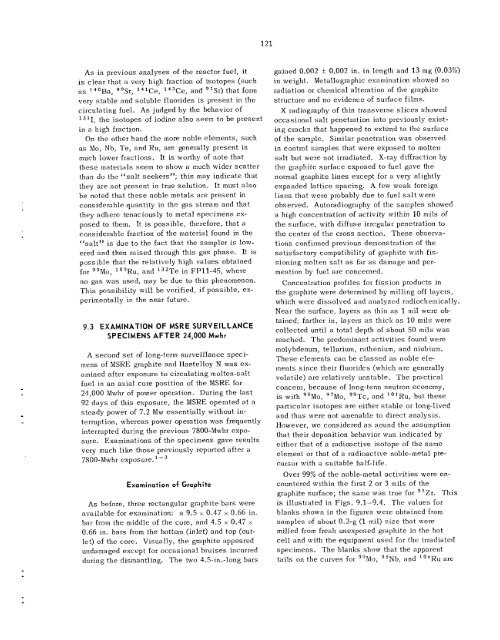ORNL-4191 - the Molten Salt Energy Technologies Web Site
ORNL-4191 - the Molten Salt Energy Technologies Web Site
ORNL-4191 - the Molten Salt Energy Technologies Web Site
You also want an ePaper? Increase the reach of your titles
YUMPU automatically turns print PDFs into web optimized ePapers that Google loves.
As in previous analyses of <strong>the</strong> reactor fuel, it<br />
is clear that a very high fraction of isotopes (such<br />
as *40Ba, 89Sr, 141Ce, 14'Ce, and "Sr) that form<br />
very stable and soluble fluorides is present in <strong>the</strong><br />
circulating fuel. As judged by <strong>the</strong> behavior of<br />
'I, <strong>the</strong> isotopes of iodine also seem to be present<br />
in a high fraction.<br />
On <strong>the</strong> o<strong>the</strong>r hand <strong>the</strong> more noble elements, such<br />
as Mo, Nb, Te, and Ru, are generally present in<br />
much lower fractions. It is worthy of note that<br />
<strong>the</strong>se materials seem to show a much wider scatter<br />
than do <strong>the</strong> "salt seekers"; this may indicate that<br />
<strong>the</strong>y are not present in true solution. It must also<br />
be noted that <strong>the</strong>se noble metals are present in<br />
considerable quantity in <strong>the</strong> gas stream and that<br />
<strong>the</strong>y adhere tenaciously to metal spe-' Limens exposed<br />
to <strong>the</strong>m. It is possible, <strong>the</strong>refore, that a<br />
considerable fraction of <strong>the</strong> material found in <strong>the</strong><br />
"salt" is due to <strong>the</strong> fact that <strong>the</strong> sampler is lowered<br />
and <strong>the</strong>n raised through this gas phase. It is<br />
possible that <strong>the</strong> relatively high values obtained<br />
for g9Mo, lo9Ru, and 132Te in FPll-45, where<br />
no gas was used, may be due to this phenomenon.<br />
This possibility will be verified, if possible, experimentally<br />
in <strong>the</strong> near future.<br />
9.3 EXAMINATION OF MSRE SURVEILLANCE<br />
SPECIMENS AFTER 24,000 Mwhr<br />
A second set of long-term surveillance speci-<br />
mens of MSRE graphite and Hastelloy N was ex-<br />
amined after exposure to circulating molten-salt<br />
fuel in an axial core position of <strong>the</strong> MSRE for<br />
24,000 Mwhr of power operation. During <strong>the</strong> last<br />
92 days of this exposure, <strong>the</strong> MSRE operated at a<br />
steady power of 7.2 Mw essentially without in-<br />
terruption, whereas power operation was frequently<br />
interrupted during <strong>the</strong> previous 7800-Mwhr expo-<br />
sure. Examinations of <strong>the</strong> specimens gave results<br />
very much like those previously reported after a<br />
7800-Mwhr exposure.' -'<br />
Examination of Graphite<br />
As before, three rectangular graphite bars were<br />
available for examination: a 9.5 x 0.47 x 0.66 in.<br />
bar from <strong>the</strong> middle of <strong>the</strong> core, and 4.5 x 0.47 x<br />
0.66 in. bars from <strong>the</strong> bottom (inlet) and top (out-<br />
let) of <strong>the</strong> cote. Visually, <strong>the</strong> graphite appeared<br />
undamaged except for occasional bruises incurred<br />
during <strong>the</strong> dismantling. The two 4.5-in.-long bars<br />
121<br />
gained 0.002 k 0.002 in. in length and 13 mg (0.03%)<br />
in weight. Metallographic examination showed no<br />
radiation or chemical alteration of <strong>the</strong> graphite<br />
structure and no evidence of surface films.<br />
X radiography of thin transverse slices showed<br />
occasional salt penetration into previously exist-<br />
ing cracks that happened to extend to <strong>the</strong> surface<br />
of <strong>the</strong> sample. Similar penetration was observed<br />
in control samples that were exposed to molten<br />
salt but were not irradiated. X-ray diffraction by<br />
th.e graphite surface exposed to fuel gave <strong>the</strong><br />
normal graphite lines except for a very slightly<br />
expanded lattice spacing. A few weak foreign<br />
lines that were probably due to fuel salt were<br />
observed. Autoradiography of <strong>the</strong> samples showed<br />
a high concentration of activity within 10 mils of<br />
<strong>the</strong> surface, with diffuse irregular penetration to<br />
<strong>the</strong> center of <strong>the</strong> cross section. These observa-<br />
tions confirmed previous demonstration of <strong>the</strong><br />
satisfactory compatibility of graphite with fis-<br />
sioning molten salt as far as damage and per-<br />
meation by fuel are concerned.<br />
concentration profiles for fission products in<br />
<strong>the</strong> graphite were determined by milling off layers,<br />
which were dissolved and analyzed radiochemically.<br />
Near <strong>the</strong> surface, layers as thin as 1 mil were ob-<br />
tained; far<strong>the</strong>r in, layers as thick as 10 mils were<br />
collected until a total depth of about 50 mils was<br />
reached. The predominant activities found were<br />
molybdenum, tellurium, ru<strong>the</strong>nium, and niobium.<br />
These elements can be classed as noble ele-<br />
ments since <strong>the</strong>ir fluorides (which are generally<br />
volatile) are relatively imstable. The practical<br />
concern, because of long-term neutron economy,<br />
is with g5Mo, 97Mo, ggTc, and "'Ru, but <strong>the</strong>se<br />
particular isotopes are ei<strong>the</strong>r stable or long-lived<br />
and thus were not amenable to direct analysis.<br />
However, we considered as sound <strong>the</strong> assumption<br />
that <strong>the</strong>ir deposition behavior was indicated by<br />
ei<strong>the</strong>r that of a radioactive isotope of <strong>the</strong> same<br />
element or that of a radioactive noble-metal pre-<br />
cursor with a suitable half-life.<br />
Over 99% of <strong>the</strong> noble-metal activities were en-<br />
countered within <strong>the</strong> first 2 or 3 mils of <strong>the</strong><br />
graphite surface; <strong>the</strong> same was true for 95Zr. This<br />
is illustrated in Figs. 9.1-9.1, The values for<br />
blanks shown in <strong>the</strong> figures were obtained from<br />
samples of about 0.2-g (1 mil) size that were<br />
milled from fresh unexposed graphite in <strong>the</strong> hot<br />
cell and with <strong>the</strong> equipment used for <strong>the</strong> irradiated<br />
specimens. The blanks show that <strong>the</strong> apparent<br />
tails on <strong>the</strong> curves for "Mo, "Nb, and '0611zu are



![Review of Molten Salt Reactor Physics Calculations [Disc 2]](https://img.yumpu.com/21979492/1/190x247/review-of-molten-salt-reactor-physics-calculations-disc-2.jpg?quality=85)












